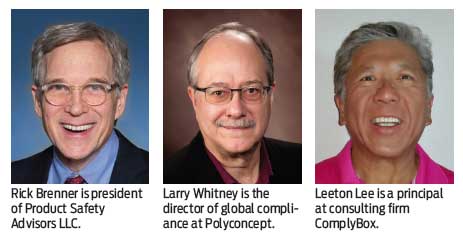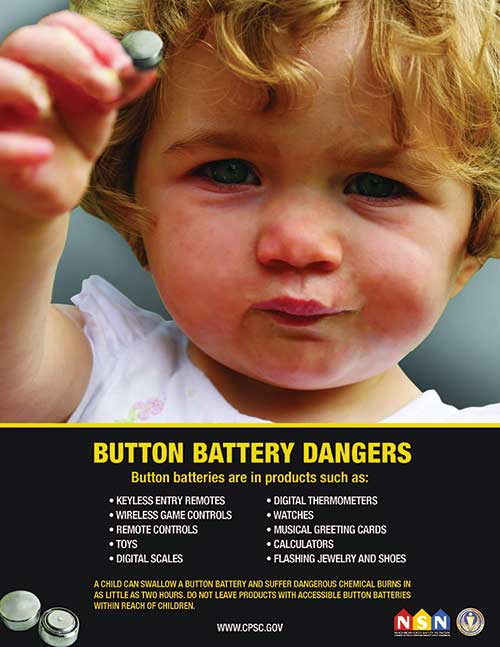August 31, 2016
Product Safety Primer for Promotional Product Pros
Still trying to understand the ins and outs of product safety? Read this primer before you get burned.
Whose job is it to make sure promotional products are safe? If you think it’s solely the responsibility of suppliers, you’re not only behind the curve, but squarely in the crosshairs of liability.

“People used to say product safety was just for the big guys – this is no longer the case,” says Denise Fenton, executive director of compliance at Quality Certification Alliance (QCA), an independent accreditation organization. “Compliance is the price of entry into the market.”
Indeed, the ad specialty market, and the clients it serves, has changed. Everyone in the supply chain now bears some burden for safety, but ultimately, your customers expect the buck to stop with you. And while this reality comes with serious obligations, it also presents real opportunity.
“It’s not just the top 100 brands that are concerned about the issue. It’s migrated much further down the line to every size of clients,” says Terry McGuire, senior VP of marketing at HALO Branded Solutions (asi/356000). “Aggressive protocols have helped us close [deals with] substantial client brands – it’s a strong selling point.”
While your company may not have the resources of a large distributorship, you can get in the compliance game by learning the lingo, knowing what to look for and being able to effectively quiz suppliers on their testing controls. Short of that, you and your clients risk operating in the dark.
“We are fiduciaries for some of the most valuable brands in the world. Their names go on the products we sell – not ours – so if we put their brand on unsafe or untested products, they take the biggest hit,” says Rick Brenner, president of Product Safety Advisors LLC. “They trust us to do the right thing.”
Where to Begin
While industry education efforts have raised product safety awareness, large knowledge gaps remain. “We see some companies that do nothing unless required by a client, and then they have a rude awakening when there’s a problem with their product,” says Karolyn Helda, managing director at testing firm AI/ANSECO.
You shouldn’t expect to learn everything there is to know about product safety in short time, but you can understand important points if you’re attentive and put in some effort. “The best way to start with compliance is to know what’s in your product – otherwise you can’t control it,” says QCA’s Fenton. Another important step to take: Find out clearly from your client who your products will be distributed to. Why? General use items have much different testing standards than children’s products.
From there, check out product safety webinars offered by suppliers, visit the Consumer Product Safety Commission (CPSC) website, and read updates and newsletters published by third-party testing labs. Another good resource is the International Consumer Product Health and Safety Organization (ICPHSO), which provides an annual symposium. In addition, St. Louis University’s Center for Supply Chain Management has a program on product safety that a growing number of industry professionals are attending, says Larry Whitney, director of global compliance at Polyconcept.

Passing, Failing & Gray Areas
One of the best ways to understand the product safety process is to learn about a few testing examples. To help distributors get a feel for what’s involved, AI/ANSECO put three common items under a safety microscope: a Magic 8 ball pen, a “Tritan” water bottle and a plush teddy bear from a university school store. Each was given a passing or failing grade.
Since most novelty pens aren’t considered to be primarily intended for kids, AI/ANSECO classified it as a general use item. The pen was “tested for phthalates and accessible components” and tested for lead, Helda says. The results showed the pen met the limits for both chemicals, with the exception of the tip of the pen. This should not be an issue, says Helda, as regulations generally focus on whether the consumer is exposed to the chemical while using the product. “Consumers don’t touch the tip of the pen when writing,” Helda says. The pen passed.
Results were a little more unclear, though, for the water bottle. First, AI/ANSECO wanted to make sure materials wouldn’t leach from the bottle into a beverage. The bottle passed this requirement. AI/ANSECO also opted to test for controversial chemical Bisphenol A (BPA) as many states now have “BPA Free” laws.
“Tritan is known to be a BPA-free material, so it’s not expected to find BPA in the product,” Helda says. However, tests showed the bottle dye contained 1.3 ppm of BPA. It’s possible, Helda says, that colorants or contaminants (accidentally) were added to the bottle, or a factory could’ve substituted polycarbonate resin to make the item. Polycarbonate is known to contain BPA and looks and feels much like Tritan, so it can be substituted without being easily detected. The bottom line: the bottle passed the “leach” test, but not the BPA-free one.
Things get even more interesting with the plush bear. Since it’s aimed at the collegiate market, one might assume it’s a general use item, and not subject to the children’s product requirements. However, some products are recognized by consumers as being appropriate for children, and most plush toys fall into this category, regardless of the fact that it has a college logo on it, says Helda. Consequently, AI/ANSECO tested the bear as a children’s toy for U.S. distribution. It passed. But that’s not the end of things. AI/ANSECO took the added step of also testing according to the toy regulations for Canada, as the lab often gets questions from promotional product clients like, “I have a passing test report for the U.S., am I OK for Canada?”
In some cases the answer is “yes” and Canada has been known to accept reports for testing according to U.S. regulations. But differences in the regulations can result in a product passing in one region and failing in the other, Helda notes. The tension test on the bear’s eye passed according to U.S regulations, but in the Canada test, the eye released a small part that would be considered a choking hazard for young children. That means the plush bear technically failed for Canada.
TSCA Reform
Testing is only one part of the compliance puzzle. Federal rules and regulations are obviously at the heart of compliance. Currently, the biggest federal regulation to keep an eye on in terms of how it may eventually affect products is the Frank R. Lautenberg Chemical Safety for the 21st Century Act, says Andy Blahnik, quality and compliance manager at Gemline (asi/56070). It was signed into law on June 22 to reform a 40-year-old chemical management measure called the Toxic Substances Control Act (TSCA), intended to protect Americans from exposure to hazardous chemicals.
“TSCA will have an impact on the industry, we just don’t know how yet,” says QCA’s Fenton. “This is the first update ever to TSCA.”
TSCA makes it mandatory for the Environmental Protection Agency (EPA) to evaluate existing chemicals with clear and enforceable deadlines, sets a new risk-based safety standard and calls for increased public transparency for chemical information, says Leeton Lee, principal at consulting firm ComplyBox.
While the industry hoped for a level playing field, with uniform regulations nationwide, the Lautenberg Act doesn’t quite deliver that. “All of us were looking for simplicity – this law isn’t it,” says Brenner.
There are still windows where states can act on their own if the EPA doesn’t act quickly enough to address a substance a state considers unsafe, says Brenner. The industry must figure out how to work within these complex parameters, by either complying with safety standards in the strictest state, not selling products in that particular state, or eliminating products containing the questionable substance from their product line altogether, according to Brenner.
The reform’s impact on the industry will trickle down within a year or two, but all suppliers and distributors should be aware of the new federal regulations and work with vendors and materials suppliers to be ready, he notes.
“The industry needs to stay on top of TSCA, but we aren’t chemical engineers. No one in our industry is creating new compounds or chemicals. We typically follow what retail does. If a chemical is widely used in retail, we will monitor the EPA and FDA and follow retail’s lead,” says Whitney.
The Latest on BPA
TSCA reform is clearly a topic to watch closely. That said, the two most widely followed sets of regulations impacting the industry are still the Consumer Product Safety Improvement Act (CPSIA) and Cal Prop 65. CPSIA imposes third-party testing and documentation, primarily on manufacturers and distributors of children’s products, and requires testing for harmful chemicals such as lead and specific phthalates.
Cal Prop 65, also known as the Safe Drinking Water and Toxic Enforcement Act of 1986, applies to all products distributed in the state of California, to protect consumers from toxic substances that can cause cancer, birth defects or other reproductive harm.
In May of 2015, BPA was added to the Cal Prop 65 list of chemicals considered by the state to cause reproductive toxicity. “Drinkware no longer contains BPA, but lots of consumer products are still made with polycarbonate. BPA is an important component in the making of polycarbonate, so our industry needs to know to avoid polycarbonate,” says Lee.
Lithium Batteries Draw Scrutiny
In product safety, it’s not just what a product is made from that matters. Other components are critical, too. “Products containing lithium-ion batteries are among the hottest products we sell, and are by far the most dangerous due to fire hazards,” says Gene Geiger, CEO of Geiger (asi/202900). The CPSC issues weekly product recall reports, and shipping companies are clamping down on how these products are packed, labeled and shipped, he notes.
 This CPSC poster warns of button battery dangers.
This CPSC poster warns of button battery dangers.
Electrical products containing inferior components can cause overheating, burns, fires or electrical shocks. To avoid this risk, buy certified products, review certification documentation for completeness and validity and verify the certified body listing on the product, says Helda. For a non-certified product, she recommends requiring a valid test report for the applicable standard.
Additionally, Fenton expects button batteries to become “the CPSC’s next big topic” due to vulnerable population risk among children, the elderly and pets. Button batteries are found in items like keyless-entry remotes, musical greeting cards, toys and a wide assortment of promotional products. According to the CPSC, a child can swallow a button battery and suffer dangerous chemical burns in as little as two hours.
CPSC Steps Up Enforcement
No doubt, the CPSC has been flexing its muscle in recent years. The CPSIA of 2008 authorized federal officials to obtain civil penalties of up to $15 million for failure to report safety hazards in a timely manner, up significantly from a previous $1.8 million cap.
The CPSC has added dramatically to staff, and is increasingly tough on violators, says Lee. In the first half of 2016, the CPSC broke last year’s record for civil penalties, with over $23 million in settlements, according to law firm Miles and Stockbridge. This included a record $15.4 million civil penalty against Gree Electric Appliances in March.
Experts suggest keeping an eye on the upcoming presidential election. While product safety doesn’t seem to be political, it is. The current five-member CPSC consists of three Democrats and two Republicans, and most votes follow party lines. Of note, one Republican CPSC commissioner recently offered a strongly worded dissenting opinion on the high penalty amount of the Gree case. Translation: A new party in the White House could significantly affect future regulatory decisions.
New Compliance Trends
Unquestionably, insiders say, independent of regulations and CPSC crackdowns, there’s a continuing movement afoot to source responsibly. Big firms are responding to consumer concerns that products are made by workers who are treated well and in a way that doesn’t harm the environment. “Buyers are demanding supply chain transparency to be assured that a fire in a Bangladesh garment factory or video showing miserable working conditions in some other country doesn’t get associated with their brand,” says Geiger.
What should you question suppliers about, regarding their factories? Whitney offers this list: Is it a clean operation? Are they treating workers fairly? Is it a safe environment? Do they segregate materials? Do they have decent internal quality controls?
Environmental compliance is also becoming a hot-button issue, says Lee. “In the last two years, factories have been audited for environmental compliance and stewardship,” he says. “Many large brands are issuing questionnaires to their distributors and suppliers regarding best practices that impact soil, water and air.”
A Supplier’s Safety Story
 Before Jornik Manufacturing Corp. (asi/63549) bought the assets of Funco in 2008, “we knew zero about compliance,” says Jornik COO Jordie Freedman. Previously Jornik sold items like pens, name badges and mouse pads, but the Funco purchase expanded its product line into beach balls and other inflatables aimed at children.
Before Jornik Manufacturing Corp. (asi/63549) bought the assets of Funco in 2008, “we knew zero about compliance,” says Jornik COO Jordie Freedman. Previously Jornik sold items like pens, name badges and mouse pads, but the Funco purchase expanded its product line into beach balls and other inflatables aimed at children.
When the Consumer Product Safety Improvement Act was signed into law in 2008, Jornik had to take a crash course in product safety, and that task was given to Freedman. She attended her first product safety summit in 2010 and started networking with industry experts and third-party-accredited testing labs, calling on them regularly with questions. “The industry safety experts were forthcoming with information and very welcoming. I never felt embarrassed to say I didn’t know an answer,” Freedman says.
Freedman paid the third-party lab to perform various individual services, such as tracking and age grading for any product that potentially would be used by kids. Cost was a huge hurdle. “We are a smaller supplier, and I am competing with much larger ones that have bigger budgets and order sizes. The cost of amortization for testing is much different for a bigger player,” says Freedman.
Her challenge was to invest in best practices but also maintain competitive pricing. “Costs went up, margins went down and I had to convince the rest of the management team that we had no choice but to bite the bullet. If we didn’t do this, we wouldn’t be able to sell product,” she says.
Jornik discussed reducing the amount of toys it carried, but ultimately decided it had a market niche in unique, creative toys. “While other people were running away from this category, we opted to run toward it and see what happened,” Freedman says.
It’s difficult work to build a compliance program, but Freedman feels her company is on the right path. She hired an industry-specific consultant to provide feedback and specific tools necessary for Jornik’s compliance program.
“Product safety compliance is the oil that keeps my engine running,” Freedman says. Management no longer questions the investment they’re making, and as Jornik grows, she expects to hire more people to support best practices. “Doors that may not have opened are opening, and I think it’s in large part because we have invested in compliance,” Freedman says.
Jean Erickson is a contributing writer for Advantages.
